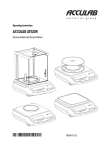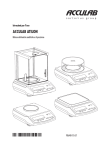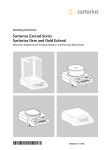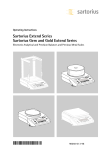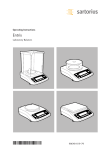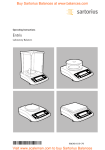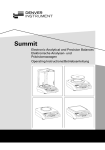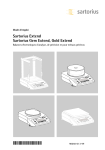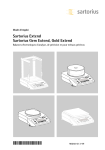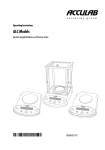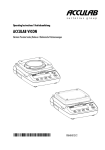Download Acculab ATL-423-V Operating instructions
Transcript
WWW.BALANCES.COM Operating Instructions ACCULAB ATILON Electronic Analytical and Precision Balances 98648-015-55 WWW.BALANCES.COM Contents 3 Warnings and Safety Precautions 44 ISO/GLP-compliant Printout/Record 4 Getting Started 46 Data Interface 5 Installation 47 Troubleshooting Guide 11 11 12 14 Operation Display and Operating Elements Basic Weighing Function Calibration/Adjustment 17 17 18 19 20 24 Configuration (Operating Menu) Functions of the Keys during Configuration Menu Navigation; Example: Setting the Language Parameter Settings: Menu Parameter Settings: Overview Input: ID Number, Date and Time 26 27 29 31 33 35 37 39 41 Application Programs Counting Weighing in Percent Calculation Animal Weighing/Averaging Net-total Formulation Totalizing Density Determination Mass Unit Conversion 2 48 Care and Maintenance 49 Recycling 50 51 55 56 57 58 Overview Specifications Accessories C-Marking Declaration of Conformity Confirmation of an EC Type-Approval Certificate WWW.BALANCES.COM Warnings and Safety Precautions Safety § To prevent damage to the equipment, please read these operating instructions carefully before using the balance. ! Do not use this equipment in hazardous areas. ! The balance may be opened only by trained service technicians. ! Disconnect the balance from power before connecting or disconnecting peripheral devices. ! If you operate the balance under ambient conditions subject to higher safety standards, you must comply with the applicable installation regulations. ! Exposure to excessive electromagnetic interference can cause the readout value to change. Once the disturbance has ceased, the instrument can be used again in accordance with its intended purpose. Make sure that no liquid enters the equipment housing; use only a slightly moistened cloth to clean the balance. – Connect only Acculab accessories, as these are optimally designed for use with your Atilon balance. The operator shall be solely responsible for installation and testing of any modifications to Acculab equipment, including connection of cables or equipment not supplied by Acculab. On request, Acculab will be happy to provide information on operating specifications (in accordance with the Standards for defined immunity to interference). $ Do not open the balance housing. If the seal is broken, this will void all claims under the manufacturer’s warranty. $ If you have any problems with your balance, contact your local customer service center. Symbols The following symbols are used in these instructions: § indicates required steps $ indicates steps required only under certain conditions > describes what happens after you have performed a particular step Installation ! Make sure the voltage rating printed on the power supply is identical to your local line voltage. – Proceed with extreme caution when using pre-wired RS-232 connecting cables, as the pin assignments may not be compatible with Acculab equipment. Before connecting the cable, check all pin assignments against the cabling diagrams and disconnect any lines that are assigned differently. – indicates an item in a list ! indicates a hazard ! If there is visible damage to the equipment or power cord, disconnect the equipment from power and lock it in a secure place to ensure that it cannot be used for the time being. 3 WWW.BALANCES.COM Getting Started Storage and Shipping Conditions – Do not expose the balance to extreme temperatures, moisture, shocks, blows or vibration. Unpacking the Equipment § After unpacking the equipment, please check it immediately for any external damage. $ If you detect any damage, proceed as directed in the chapter entitled “Care and Maintenance,” under “Safety Inspection.” $ Save the box and all parts of the packaging for any future transport. Disconnect all cables before packing the balance for shipping. – – – – Equipment Supplied Balance Weighing pan Pan support (only for models with a round weighing pan) AC adapter – – – – Installation Choose a location that is not subject to the following negative influences: Heat (heater or direct sunlight) Drafts from open windows and doors Excessive vibration during weighing Excessive moisture Conditioning the Balance Moisture in the air can condense on cold surfaces whenever the equipment is moved to a substantially warmer place. To avoid the effects of condensation, allow the balance to sit for 2 hours, at room temperature, before plugging into AC power. Seal on Balances Verified for Use in Legal Metrology in the EU*: For instruments of accuracy class K, EU legislation requires that a control seal be affixed to verified balances. The control seal consists of a sticker. If the seal is broken, the verification becomes null and void and the balance must be re-verified. Additional equipment supplied with models ATL-224, -124: – Sliding-door draft shield – Drip/breeze ring – Draft shield base plate Additional equipment supplied with models ATL-623, -423, -153: – Round glass draft shield with cover * Including the Signatories of the Agreement on the European Economic Area 4 WWW.BALANCES.COM Installation § – – – – Setting Up the Balance Instruments with sliding-door draft shield: Place components inside the chamber in the following order: Draft shield base plate Drip/breeze ring Pan support Weighing pan § – – – – – Instruments with a round glass draft ring: Position the components listed below in the order given: Place the lower lid on the balance with the raised edge facing upwards Pan support Weighing pan Glass draft ring Place the upper lid on the draft shield ring with the raised edge facing downwards Instruments with a round weighing pan § Position the components listed below in the order given: – Pan support – Weighing pan Instruments with a rectangular weighing pan: § Place the weighing pan on the balance 5 WWW.BALANCES.COM – – § § Connecting the Balance to AC Power/Safety Precautions Use only original Acculab AC adapters. For use within Europe: part no. 6971412 U.S./Canada: part no. 6971413 1) Connect the angle plug to the balance 2) Connect the AC adapter to the wall outlet (mains) AC Adapter with Country-specific Power Cord Some models come with separate country-specific power cords for the AC adapter. § 1) Connect the angle plug to the balance § 2) Select the power cord for your area and connect it to the AC adapter § 3) Plug the power cord into the wall outlet (mains) Use an original Acclulab AC adapter with a wide input voltage range $ (100 to 240 V~), order no. 6971966, and replaceable power cord: 6900900 (Europe) 6900905 (AUS) 6900901 (US/CDN) 6900902 (ZA) 6971945 (UK) 6971977 (Argentina) 6971973 (India) 6971978 (China) 6971980 (Denmark) 6971975 (Israel) 6971776 (Italy) Safety Precautions Plug-in AC Adapter 6971412/6971413: The AC adapter rated to Class 2 can be plugged into any wall outlet without additional safety precautions. Benchtop AC Adapter 6971966: The AC adapter rated to Class 1 can be plugged into any wall outlet without additional safety precautions. The ground terminal is connected to the balance housing, which can be additionally grounded for operation. The data interface is also electrically connected to the balance housing (ground). 6 WWW.BALANCES.COM NOTE: This equipment has been tested and found to comply with the limits pursuant to part 15 of FCC Rules. These limits are designed to provide reasonable protection against harmful interference. This equipment generates, uses and can radiate radio frequency energy and, if not installed and used in accordance with these instructions, may cause harmful interference to radio communications. For information on the specific limits and class of this equipment, please refer to the Declaration of Conformity. Depending on the particular class, you are either required or requested to correct the interference. If you have a Class A digital device, you need to comply with the FCC statement as follows: “Operation of this equipment in a residential area is likely to cause harmful interference in which case the user will be required to correct the interference at his own expense.” If you have a Class B digital device, please read and follow the FCC information given below: “However, there is no guarantee that interference will not occur in a particular installation. If this equipment does cause harmful interference to radio or television reception, which can be determined by turning the equipment off and on, the user is encouraged to try to correct the interference by one or more of the following measures: – Reorient or relocate the receiving antenna. – Increase the separation between the equipment and receiver. – Connect the equipment into an outlet on a circuit different from that to which the receiver is connected. – Consult the dealer or an experienced radio/TV technician for help.” Before you operate this equipment, check which FCC class (Class A or Class B) it has according to the Declaration of Conformity included. Be sure to observe the information of this Declaration. 7 WWW.BALANCES.COM Connecting Electronic Peripheral Devices § Make sure to unplug the balance from AC power before you connect or disconnect a peripheral device (printer or computer) to or from the interface port. Warmup Time To ensure accurate results, the balance must warm up before operation as follows: – Models ATL-153 and ATL-822: 2 hours – All other models: 30 minutes Only after this time will the instrument have reached the required operating temperature. Using Verified Balances in Legal Metrology in the EU*: $ Make sure to allow the equipment to warm up for at least 24 hours after initial connection to AC power or after a relatively long power outage. Operation Outside the Temperature Range ! Operating the balance beyond the temperature range of +10…+30°C (50°…86°F). Differences from the specifications listed in the chapter on “Specifications” are possible. * Including the Signatories of the Agreement on the European Economic Area 8 WWW.BALANCES.COM Below-Balance Weighing A port for a below-balance weighing hanger is located on the bottom of the balance. $ Below-balance weighing is not permitted in legal metrology. § Open cover plate on the bottom of the balance. Important: set the balance on its side to access the cover plate. DO NOT turn the balance upside-down. § Using the built-in hook 1: Attach the sample (e.g., using a suspension wire) to the hanger. $ Install a shield for protection against drafts if necessary. 1 9 WWW.BALANCES.COM Leveling the Balance Purpose: – To compensate for unevenness at the place of installation Always level the balance again any time after it has been moved to a different location. Only the 2 front feet are adjusted to level the balance. L R § Retract the two rear feet (only on models with a rectangular weighing pan). R L § Turn the 2 front feet as shown in the diagram until the air bubble is centered within the circle of the level indicator. > In most cases this will require several adjustment steps. R L § On models with a rectangular weighing pan: Lower the 2 rear feet until they touch the surface on which the balance rests. Anti-theft Locking Device § To secure the balance at the place of installation, fasten a chain or a lock to the lug located on the rear panel of the balance. $ Anti-theft locking device (chain and lock): order number LC-1 10 WWW.BALANCES.COM Operation Overview of Display Elements 1 2 12 11 10 3 9 8 7 4 5 6 Pos. Designation 1 2 3 4 5 6 7 8 9 10 Pos. Designation Weight unit Menu level indicator Symbol: “GLP printing mode active” Symbol: “Printing mode active” Symbol: “Application program active” Calculated-value indicator (i.e., not a weight value) Symbol: Gross or net value Symbols for active application (W, Z, L, V, R, A, C) Symbol: Calibration/adjustment function Symbols for zero range 11 12 << < V > ↵ Busy symbol: command is being processed (for example, “Wait for stability icon); after you turn on the power, A will be displayed until you press a key Weight value displayed in selected weight unit Symbols: Save settings and exit the operating menu One menu level higher Scroll through menu items Next item on current menu level Select a parameter setting Overview of Operating Elements 1 ATILON 2 ON/OFF 8 CLEAR MENUE ZERO ENTER TARE Pos. Designation Pos. Designation 1 2 3 4 6 7 8 5 CAL 3 4 5 7 6 On/off Level indicator Start calibration/adjustment routine Data output: Press this key to send readout values to the built-in data interface. Taring PRINT Start an application program Open the operating menu | Select an application program Clear This key is generally used to cancel functions: – Quit application program – Cancel calibration/adjustment routine | Exit the operating menu 11 WWW.BALANCES.COM Basic Weighing Function Features – Taring the balance – Printing weights Preparation § Switch on the balance: Press (ON/OFF) § Tare the balance, if necessary: Press (TARE) $ If necessary, change the configuration settings: See the chapter entitled “Configuration” $ If desired, load the factory settings: See the chapter entitled “Configuration” Using Verified Balances as Legal Measuring Instruments in the EU*: The type-approval certificate for verification applies only to non-automatic weighing instruments. For automatic operation with or without auxiliary measuring devices, you must comply with the regulations applicable to the place of installation. § Before using the balance as a legal measuring instrument, calibrate and adjust it at the place of use using the built-in motorized calibration weight; for details, see “Calibration/Adjustment” in this chapter. $ The temperature range (°C) indicated on the verification label must not be exceeded during operation. Additional Functions $ Switching off the balance: Press (ON/OFF) $ Balance in standby mode: the current time is displayed * Including the Signatories of the Agreement on the Eruopean Economic Area 12 WWW.BALANCES.COM Example Simple Weighing Step Key (or instruction) Display/Printout Balance in standby mode 1. Switch on the balance Self-test is performed, followed by automatic initial tare function. 10:32:30 (ON/OFF) 2. Place container on weighing pan (in this example: 11,5 g). 3. Tare the balance + (TARE) 4. Place sample in container (in this example: 132 g). 5. Print weight 0.0 g 0.0 g + (PRINT) 11.5 g N 132.0 g + 132.0 g 13 WWW.BALANCES.COM Calibration and Adjustment Purpose Calibration is the determination of any difference between the measured value displayed and the true weight (mass) of a sample. Adjustment is the correction of this difference, or its reduction to an allowable level within maximum permissible error limits. To block calibration/adjustment: – Select Cal.-Adj.-blocked in the menu – Close the menu access switch on the back of the balance Using Verified Balancess as Legal Measuring Instruments in the EU*: Before using your balance as a legal measuring instrument, internal calibration must be performed at the place of installation. – – – – Features Calibration/adjustment can be performed only when: there is no load on the balance the balance is tared the internal signal is stable for external calibration, the value displayed for the calibration weight on the balance does not differ from the nominal weight value by more than 2% If these conditions are not met, an error message is displayed “Err 02”. You can use any of the following weight units in calibration/adjustment: CAL.Einh. - gramm, Kilogr. or Pound (not for verified models) External Calibration in Verified Balances When the balance is used in legal metrology, external calibration is blocked as follows: – The setting of the menu access switch is locked (see “To block calibration/adjustment”) – The cap over the menu access switch is sealed For details on generating an ISO/GLP-compliant printout of calibration/adjustment results, see page 43. Following calibration/adjustment, the application program is cleared. Internal Calibration/Adjustment In the operating menu, select Cal.-Adj.-Cal.Int. before beginning. The built-in motorized calibration weight is applied and removed automatically for internal calibration. § > > > Select calibration/adjustment: Press (CAL) The built-in weight is applied automatically The balance is adjusted The built-in calibration weight is removed. * Including the Signatories of the Agreement on the European Economic Area 14 WWW.BALANCES.COM Internal Calibration/Adjustment (Only on ATL…-I und ATL…-V models) Set the following parameters: SETUP - Waage - CAL.Just. - Cal.Int. (menu code 1.1. 9. 4) The built-in motorized calibration weight is applied and removed automatically for internal calibration. Step Key (or instruction) 1. Unload and tare the balance (TARE) 2. Start calibration (CAL) The built-in weight is applied automaticallyg 3. Calibration/adjustment executed 4. The built-in weight is removed Display 0.0 g CAL.Int. g CAL.RUN. CAL.end g 0.0 g 15 WWW.BALANCES.COM External Calibration Parameters (changes in factory settings): SETUP - Waage - CAL.Just. - Cal.Ext. (menu code 1.1. 9. 1) The required calibration weight is configured at the factory (see “Specifications”) Step Key (or instruction) 1. Unload and tare the balance (TARE) 2. Start calibration. (CAL) Display 0.0 g Cal.Ext. g Once you store the zero point the required calibration weight is prompted (flashing display) - 5000.0 g 3. Apply the prompted calibration weight (in this example: 5000 g) Weight too light: a minus sign “–” is shown Weight too heavy: a plus sign “+” is shown 5000.0 g The display stops flashing as soon as the weight value is within the defined limit. 4. Calibration/adjustment executed; then the calibration weight is displayed 5. Remove the calibration weight 16 Cal.end g + 5000.0 g 0.0 g WWW.BALANCES.COM Configuration (Operating Menu) You can configure the balance; i.e., adapt it to individual requirements. Functions of the Keys during Configuration Symbol V > ↵ << < Key (MENU)* Press and hold (ENTER) (ENTER) (CLEAR) Press and hold (CLEAR) (CLEAR) Function Scroll through menu items One menu level lower Confirm menu item Save settings and exit menu from any position Save settings and exit menu One menu level higher Indicates menu level * On some models, the keypad overlay shows the German word “MENUE“ for MENU. 17 WWW.BALANCES.COM Menu Navigation Example: Setting the Language Step Key (or instruction) Display 1. Open the menu: In weighing mode: first menu item is shown (MENU)* (hold) Applic. 2. Scroll upward within the menu level; after the last menu code, the first code is displayed again Repeatedly: (MENU)* Input ... languag. 3. Select menu level Repeatedly: (ENTER) (scrolls to the right) english o 4. Change setting: Scroll until the desired setting is shown (MENU)* Espanol 5. Confirm the menu code; “o” indicates the active setting (ENTER) Espanol o 6. Return to the next higher menu level (from the second level) (CLEAR) Lengua $ Set other menu items as desired (MENU)*, (ENTER) 7. Save settings and exit menu Repeatedly: (CLEAR) or $ Exit menu without saving changes (ON/OFF) > Restart your application * On some models, the keypad overlay shows the German word “MENUE“ for MENU. 18 0.0 g WWW.BALANCES.COM Parameter Settings: Menu Level 1 Level 2 Level 3 Menu code Setup Bal.Scal. Balance parameters Ambient Ambient conditions app.fil. Application filter Stab.Rng. Stability range Taring Taring 1) AutoZer. Auto zero Wt.Unit Basic weight unit Display Display accuracy1) Cal./adj. Function of the (CAL) key Cal.Unit. Weight unit for calibratio 1) Baud Baud rate parity Parity Stopbit Number of stop bits handshk. Handshake mode databit Number of data bits Dat.Rec. Output: SBI (ASCII) or printout Print (manual/automatic) StopAut. Stop automatic printing Tar./prt. Tare balance after ind. print Prt.Init. Printout of appl. parameters format Line format for printout GLP ISO/GLP-compliant printout time 12h/24h date-Format Menu Signal Acoustic signal (beep) Keys Keypad ext. Keys. Funktion external Keypad On Mode Power-on mode Backlit Display backlighting menu Factory settings 1. 1. 1. 1. 1. 2. 1. 1. 3. 1. 1. 5 1. 1. 6 1. 1. 7. 1. 1. 8. 1. 1. 9. 1. 1.11. 1. 5. 1. 1. 5. 2. 1. 5. 3. 1. 5. 4. 1. 5. 5. 1. 5. 6. 1. 6. 1. 1. 6. 2. 1. 6. 4. 1. 6. 5. 1. 6. 6. 1. 6. 7. 1. 6. 8. 1. 6. 9. 1. 8. 1. 1. 8. 2. 1. 8. 3. 1. 8. 4. 1. 8. 5. 1. 8. 6. 1. 9. 1. 2. 1. 2. 2. 2. 2. 3. 1. 2. 3. 2. 2. 4. 1. 2. 5. 1. 2. 6. 1. 2. 7. 1 2. 7. 2. 2. 8. 1. 2. 8. 2. 2. 9. 1. Interf. Interface Prnt.Out Settings for print function extras Additional functions reset Applic. Application programs Weigh Unit Toggle wt. unit Count Density Density determination Disp.Dig. Display accuracy 1) Counting. Resolut. Resolution Ref.Updt. Autom. ref. sample updating Dec.Plcs Decimal places Comp.Prt. Printout of components Comp.Prt. Printout of components Activty. Animal activity start Method (operator) Dec.Plcs Decimal places Dec.Plcs Decimal places Input Input ID no., Date, time Input: ID no., date, time 3. 1./2./3. Info Information Version , Ser. No. , Model Display software ver., serial no., model 4. 1./2./3. Languag. English (factory setting) Deutsch German Franc. French Ital. Italian Espanol Spanish PyCCKV1V1 Russian polski Polish Codes Menu shows codes (not texts) Percent Weighing in percent Net-Tot Net-total formulation Total Totalizing AnimalW. Animal weighing Calc. Calculation . 5. 1. 5. 2. 5. 3. 5. 4. 5. 5. 5. 6. 5. 7. 5. 8. 1 ) Setting cannot be changed on verified balances 19 WWW.BALANCES.COM Parameter Settings: Overview ο = Factory setting √ = User-defined setting Level 1 Level 2 Level 3 Level 4 Setup Bal.Scal. Balance parameters Ambient Ambient conditions (Filter adaptation) V.Stable Very stable ο Stable Unstabl V.Unstbl. Very unstable 1. 1. 1. 1 1. 1. 1. 2 1. 1. 1. 3 1. 1. 1. 4 App.filt. Application filter ο Final.Rd. Final readout mode Filling Filling mode 1. 1. 2. 1 1. 1. 2. 2 Stab.Rng. Stability range 1/4-Dig. (digit) 1/2-Dig. 1-Digit ο 2-Digit 4-Digit 8- Digit1) 1. 1. 3. 1 1. 1. 3. 2 1. 1. 3. 3 1. 1. 3. 4 1. 1. 3. 5 1. 1. 3. 6 Taring 1) Taring AutoZer. Disp.Dig. ) 1 Display accuracy Cal./adj. Function of the (CAL) key Cal.Unit. Unit1) for calibration weight ) Setting cannot be changed on verified balances ) Only on ATL-…-I, ATL-…-V models 20 1. 1. 5. 1 1. 1. 5. 2 Off 1. 1. 6. 1 1. 1. 6. 2 For list of units, see “Toggling between Weight Units” Wt.Unit Basic weight unit 2 W/o Stb W/o stability W/ StAb After stability ο On Auto zero 1 o Menu code ο All Minus 1 1. 1. 7. 1 1. 1. 7. 23 1. 1. 8. 1 1. 1. 8. 2 ο Cal. ext. External cal./adj.1) Cal. int. Internal cal./adj.2) Blocked (CAL) key blocked 1. 1. 9. 1 1. 1. 9. 2 1. 1. 3. 3 ο Grams 1. 1.11. 1 1. 1.11. 2 1. 1.11. 3 Kilogr. Kilograms Pounds1) WWW.BALANCES.COM Level 1 Level 2 Level 3 Setup Interf. Interface Baudrate 600 ο 1200 2400 4800 9600 19200 1. 5. 1. 3 1. 5. 1. 4 1. 5. 1. 5 1. 5. 1. 6 1. 5. 1. 7 1. 5. 1. 8 Parity Parity ο Odd Even None 1. 5. 2. 3 1. 5. 2. 4 1. 5. 2. 5 StopBit No. of stop bits ο 1 Stop 2 Stop 1. 5. 3. 1 1. 5. 3. 2 Handshk. Handshake mode Softw.are ο Hardw.are None 1. 5. 4. 1 1. 5. 4. 2 1. 5. 4. 3 DataBit No. of data bits ο 7 Bits 8 Bits 1. 5. 5. 1 1. 5. 5. 2 Dat.Rec. Communication mode SBI (ASCII) 1) ο Printer (GLP-printout) 1. 5. 6. 1 1. 5. 6. 2 Print (manual/ automatic) Man. W/o W/o stability ο Man.With W/ stability Aut. W/o Autom. w/o stability Aut.With. Autom. w/ stability 1. 6. 1. 1 1. 6. 1. 2 1. 6. 1. 3 1. 6. 1. 4 StopAut. Stop automatic printing ο Off Not possible On Use print key (PRINT) 1. 6. 2. 1 1. 6. 2. 2 aut.Cycl. Time-dependent automautomatic printing ο EachVAl (1 display update) 1. 6. 3. 1 Tar./prt. Tare the balance after individual printout ο off On 1. 6. 4. 1 1. 6. 4. 2 Prnt.Out Printing fct. Level 4 Menu code ) Note concerning verified balances as legal measuring instruments in the EU*: In the setting “SBI”, the non-verified display digit is not automatically identified. Please take the corresponding measures or adjust the settings on the peripheral device. 1 * Including the signatories of the Agreement on the European Economic Area. 21 WWW.BALANCES.COM Level 1 Level 2 Level 3 Setup Prnt.Out Printing Prt.Init. Printing application parameters Off ο All All parameters MainPar. Main parameters 1. 6. 5. 1 1. 6. 5. 2 1. 6. 5. 2 Format Line format for printout 16 Char. 16 characters (w/o ID) ο 22 Char. 22 characters (w/ ID) 2 Char. 2 characters (w/ ID) (Date/Time and weight value) 1. 6. 6. 1 1. 6. 6. 2 1. 6. 6. 3 GLP Printout as ISO/GLPcompliant ο Off Cal.-adj. Only for calib./adj. Always All printouts 1. 6. 7. 1 1. 6. 7. 2 1. 6. 7. 3 Extras Additional functions Reset Reset menu Level 4 time 24 h 24-hour format 12 h 12-hour format “AM/PM” 1. 6. 8. 1 1. 6. 8. 2 date dd.mmm.yy Day/month/year mmm.dd.yy Month/day/year 1. 6. 9. 1 1. 6. 9. 2 Menu* ο CanEdit Can change settings Rd. Only Read only 1. 8. 1. 1 1. 8. 1. 2 Signal Acoustic signal Off ο On 1. 8. 2. 1 1. 8. 2. 2 Keys Keypad ο Free Locked 1. 8. 3. 1 1. 8. 3. 2 ext.Key Function of the external switch ο print key z/tare key (TARE) cal key (CAL) select key (MENU)* CF key (CLEAR) enter key 1. 8. 4. 1 1. 8. 4. 2 1. 8. 4. 3 1. 8. 4. 4 1. 8. 4. 5 1. 8. 4. 9 On Mode Power-on mode ο Off/On Off/on/standby Standby On/standby Auto On Auto on 1. 8. 5. 1 1. 8. 5. 2 1. 8. 5. 3 Backlit Display backlighting Off ο On 1. 8. 6. 1 1. 8. 6. 2 Menu* Factory settings Yes Restore defaults ο No Do not restore defaults 1. 9. 1. 1 1. 9. 1. 2 * On some models, the keypad overlay shows the German word “MENUE“ for MENU. 22 Menu code WWW.BALANCES.COM Level 1 Level 2 Applic. Applic. programs Weigh Unit Toggle units Level 4 Menu code Disp.Dig.1) Display accuracy ο All Minus 1 2. 1. 2. 2. 2. 1 2. 2. 2. 2 Resolut. Resolution ο Disp.Acc. Display accuracy 10-fold 10 times > disp. 2. 3. 1. 1 2. 3. 1. 2 Ref.Updt. Autom. reference updating ο Off Auto 2. 3. 2. 1 2. 3. 2. 2 Percent Weighing in percent Dec.Plcs Decimal places None No dec. places ο 1 Dec.Pl. 1 decimal place 2 Dec.Pl. 2 decimal places 3 Dec.Pl. 3 decimal places 2. 4. 1. 1 2. 4. 1. 2 2. 4. 1. 3 2. 4. 1. 4 Net-Tot Net-total Comp.Prt. Component printout Off ο On 2. 5. 1. 1 2. 5. 1. 2 Total Totalizing Comp.Prt. Component printout Off ο On 2. 6. 1. 1 2. 6. 1. 2 AnimalW. Animal weighing Activty. Animal activity Calm (fluct.: 2% of test obj.) ο Active (fluct.: 5% of test obj.) V.Active(fluct.: 20% of test obj.) 2. 7. 1. 1 2. 7. 1. 2 2. 7. 1. 3 Start Manual ο Auto. Automatic 2. 7. 2. 1 2. 7. 2. 2 Method (operator) ο Mul. Multiplier Div. Divisor 2. 8. 1. 1 2. 8. 1. 2 Dec.Plcs Decimal places None No dec. places ο 1 Dec.Pl.1 decimal place 2 Dec.Pl.2 decimal places 3 Dec. Pl. 3 decimal places 2. 8. 2. 1 2. 8. 2. 2 2. 8. 2. 3 2. 8. 2. 4 Dec.Plcs Decimal places None No dec. places ο 1 Dec.Pl.1 decimal place 2. 9. 1. 1 2. 9. 1. 2 Counting Calc. Calculation Density Density determination Level 3 1 ) Setting cannot be changed on verified balances 23 WWW.BALANCES.COM Input: ID number, Date and Time Level 1 Level 2 Level 3 Menu Code Input Input ID No. 3. 1. DATE ID input for ISO/GLP compliant data record; 7 characters max. Permitted characters: 0 to 9; A to Z; dash/hyphen; space Menu item for setting the date 3. 2. TIME Menu item for setting the time 3. 3. Depending on the setting you select for the menu item “SETUP-PRNT.OUT-DATE,” the date will be displayed in the following format: Format Display: Date DD.MMM.YY MMM.DD.YY Depending on the setting you select for the menu item “SETUP-PRNT.OUT-TIME,” the time will be displayed in the following format: Time 24-hour format 12-hour format 24 Display: Time WWW.BALANCES.COM Example: ID No., Date and Time Step Key (or instruction) Display 1. Open the menu:In weighing mode; first menu item is displayed (MENU)* hold APPLIC. 2. Select “Input” (MENU)* Input 3. Select input for ID no. twice (ENTER) ID NO. 4. Set or change the ID no. – hold down key to automatically change the digit(s): (MENU)* (MENU)* hold 3------ 5. Scroll within the 7-digit (ENTER) or (CLEAR) 3-aBC12 6. Save input when you have reached the last digit of the ID no. (ENTER) ID NO. 7. “Select “Date” (MENU)*, (ENTER) FEB. 08. 8. Change setting – hold down key to automatically change the digit(s) (MENU)* (MENU)* hold FEB. 10. 9. Toggle between Day/Month/Year positions (ENTER) or (CLEAR) FEB. 10. 10. Save setting when you reach the “YEAR” position (ENTER) datE 11. Select “Time” (MENU)*, (ENTER) 10.46.23 12. Change setting – change the digit(s): (MENU)* (MENU)* hold 11.46.23 13. Toggle between Hour/Minute/Second positions (ENTER) or (CLEAR) 11.46.32 14. Set seconds to zero (MENU)* 11.47.00 15. Save setting when you have reached the “second” position (ENTER) Time 16. Save all settings and exit the menu repeatedly (CLEAR) > Restart your application 0.0 g * On some models, the keypad overlay shows the German word “MENUE“ for MENU. 25 WWW.BALANCES.COM Device Information Level 1 InFormation Level 2 Level 3 Example Menu code version Show software version rel.36.03 4. 1. Ser. No. Show serial number To toggle focus between upper and lower display sections, press (MENU)* 10801234 4. 2. model Show model designation (to change focus from upper to middle to lower display section and back, press (MENU)* Atl-8201 4. 3. Display of Menu Items: Text or Codes Languag. English (factory setting) Deutsch German Franc. French ital.Italian Espanol Spanish pyccKV1V1 Russian polski Polish codes Menu shows codes (not texts) Application Programs Using Verified Balances as Legal Measuring Instruments in the EU*: All application programs can be selected on balances used as legal measuring instruments. Calculated values are alternately indicated with the following symbols: – Percent =% – Piece count (Counting) = pcs – Computed value = o, G * On some models, the keypad overlay shows the German word “MENUE“ for MENU. 26 5. 1. 5. 2. 5. 3. 5. 4. 5. 5. 5. 6. 5. 7. 5. 8. WWW.BALANCES.COM Counting Display symbol: Z Purpose With the Counting program you can determine the number of parts that each have approximately equal weight. To do this, a known number of parts (the reference sample quantity) is weighed first, and the individual piece weight (reference weight) is calculated from this result. Thus the number of parts subsequently placed on the balance can be determined from their weight. Preparation § Select the Counting application in the menu: see “Configuration.” § Set the following parameters: Changing the Reference Sample Quantity Activate function: Press the (MENU)* key Select the desired reference sample quantity (1 to 100): In increments of 1: Press the (MENU)* key briefly In increments of 10: Press and hold the (MENU)* key. The quantity is stored in battery-backed memory. Reference Sample Updating Automatic reference sample updating optimizes the counting accuracy. You can activate or deactivate this function in the menu. Automatic reference sample updating is performed when the requirements, including the specified stability criterion, have been met. The abbreviation opt, for “optimizing”, is displayed briefly with the new reference sample quantity. Applic. Application program Count. Resolut. Resolution o Disp.Acc. Display accuracy 10-fold 10-fold higher Ref.Updt. Autom. ref. sample updating o Off Autom. Display accuracy Automatic Printout: Counting nRef wRef Qnt + 10 : Reference sample quantity + 21.14 g : Reference weight + 500 pcs : Calculated quantity o = Factory setting * On some models, the keypad overlay shows the German word “MENUE“ for MENU. 27 WWW.BALANCES.COM Example : Counting parts of equal weight Parameter: Applic. - Count. (menu code 2. 3.) Step Key (or instruction) 1. Place empty container on the balance 2. Tare the balance Display/Data output + 22.6 g (TARE) 0.0 g 3. Add reference sample quantity to container (in this example: 20 pcs) 4. Changing the reference sample quantity: (MENU)* ref 10pcs 5. Select reference sample quantity: In increments of 1 (1, 2, 3, etc. to 100) In increments of 10 (10, 20, etc. to 100) Repeatedly: (MENU)* Press briefly (MENU)* press and hold ref 20pcs 6. Confirm selected reference sample quantity and start application. The current reference weight remains stored until a new reference weight remains stored until a new reference is set or the power supply is interrupted (ENTER) + 20pcs nRef wRef 7. Add desired number of pieces. + * 20 pcs 1.07 g 500pcs 8. If desired, print quantity (PRINT) Qnt 9. Toggle display between mean piece weight, weight, quantity Repeatedly: (MENU)* 1.07 gG + 535.0 g * + 500pcs * 10. Unload the balance + * – 21pcs 11. Repeat as needed, starting from step 7 12. Delete reference value (CLEAR) * On some models, the keypad overlay shows the German word “MENUE“ for MENU. 28 500 pcs 0.0 g * WWW.BALANCES.COM Weighing in Percent Display symbol: % Purpose This application program allows you to obtain weight readouts in percent which are in proportion to a reference weight. Preparation § Select the Weighing in percent application in the menu: see “Configuration.” Changing the Reference Percentage Activate function: Press the (MENU)* key Select the desired reference (1 to 100): In increments of 1: Press the (MENU)* key briefly In increments of 10: Press and hold the (MENU)* key. The percentage is stored in battery-backed memory. § Set the following parameters: Applic. Application program Percent Weighing in percent Dec.Plcs. Decimal places None No decimal places o 1 Dec. Pl. 1 decimal place 2 Dec. Pl. 2 decimal places 3 Dec. Pl. 3 decimal places Printout: Weighing in percent pRef Wxx% Prc : Reference percentage : Reference weight net xx% for selected reference percentage 94.9 % : Calculated reference percentage 100 111.6 g + o = Factory setting * On some models, the keypad overlay shows the German word “MENUE“ for MENU. 29 WWW.BALANCES.COM Example: Determining residual weight in percent Parameter settings: Applic. Percent (menu code 2. 4.) Reference percentage: Ref 100% Step 1. Tare the balance Key (or instruction) Display/Data output (TARE) 0.0 g 2. Place sample equal to 100% on the balance (in this example: 111.6 g) 3. Information: Enter reference percentage (Changing the reference: see the previous page) 4. Initialize the balance The current reference weight remains stored until a new reference is set or the power supply is interrupted (MENU)* ref 100 % (MENU)* + 100.0 % pRef Wxx% * + 100 % 111.6 g 5. Remove sample (e.g., for drying) 6. Place unknown weight on balance (in this example: 105.9 g) + 94.9 % * 7. If desired, print percentage (PRINT) Prc 8. Toggle display between weight and percentage Repeatedly: (MENU)* + + 105.9 g * 94.9 % * 9. Clear display of residual weight and reference percentage (CLEAR) + 105.9 g 10. If desired, print net residual weight (PRINT) N * On some models, the keypad overlay shows the German word “MENUE“ for MENU. 30 + + 94.9 % 05.9 g WWW.BALANCES.COM Calculation Display symbol: C Purpose With this application program you can calculate weight value using a multiplier or divisor. This can be used, for example, to determine the weight per unit area, or “gsm” weight (grams per square meter), of paper. Preparation § Select the Calculation application in the menu: see “Configuration.” Setting the Factor or Divisor Activate function: Press the (MENU)* key Select a number of up to 7 digits and, if needed, one decimal point (0.000001 to 9999999): In increments of 1: Press the (MENU)* key briefly To increase the value without pressing repeatedly: Press and hold the (MENU)* key. The selected operator is stored in battery-backed memory. § Set the following parameters: Applic. Application program Calc. Calculation Method (Operator) o Mul. Multiplier div. Divisor Printout: Calculation Mul Div Res + 1.2634 : Multiplier + 0.6237 : Divisor + 79.7 o : Result Dec.Plcs. Decimal places None No Decimal places o 1Dec. Pl. 1 Decimal places 2Dec. Pl. 2 Decimal places 3Dec. Pl.. 3 Decimal places o = Factory setting * On some models, the keypad overlay shows the German word “MENUE“ for MENU. 31 WWW.BALANCES.COM Example: Calculating the weight per unit area of paper: An A4 sheet of paper is used in this example, with surface dimensions of 0.210 m + 0.297 m = 0.06237 m2. To determine the weight per unit area, the total weight is divided by the surface. Parameter settings: Applic. Calc.-Method-Div. (menu code 2. 8. 1. 2) Step Key (or instruction) 1. Tare the balance (TARE) 2. Activate divisor input (MENU)* 3. Set the divisor (in this example: 0.06237): (ENTER), Display/Data output 0.00 g ______0. Position the decimal point, 5+ (MENU)*, 2+ (ENTER), __.00000 Enter numerals Repeatedly (MENU)* or press and hold: (ENTER), etc. __.06000 __.06237 (ENTER) + 4. Store the divisor and initialize the balance The current divisor remains stored in battery-backed memory until the setting is changed 5. Weight per unit area: Place an A4 sheet of paper on the balance + 6. If desired, print result (PRINT) Res 7. Toggle display between weight and calculated value Repeatedly: (MENU)* + + 8. Unload the balance 9. Repeat as needed, starting from Step 5 * On some models, the keypad overlay shows the German word “MENUE“ for MENU. 32 0.0 o Div + 0.6237 79.7 o * + 79.7 o 4.97 g * 79.7 o * 0.0 o * WWW.BALANCES.COM Animal Weighing/Averaging Display symbol: V Purpose Use this program to determine the weights of unstable samples (e.g., live animals) or to determine weights under unstable ambient conditions. With this program, the balance calculates the weight as the average of a defined number of individual weighing operations (also referred to as “subweighing operations”). Preparation § Select the Animal weighing application in the menu: see “Configuration.” Changing the Number of Subweighing Operations Activate function: Press the (MENU)* key Select the desired number of measurement (1 to 100): In increments of 1: Press the(MENU)* key briefly In increments of 10: Press and hold the (MENU)* key. The selected number of measurements is stored in battery-backed memory § Set the following parameters: Printout: Animal weighing Applic. Application program AnimalW. Animal weighing : Number of subweighing operations x-Net + 410.1 g : Calculated average mDef 20 activty. Animal activity Calm Stable readout o Active Unstable V.Active Very unstable readout Start manual o Autom. Automatic o = Factory setting * On some models, the keypad overlay shows the German word “MENUE“ for MENU. 33 WWW.BALANCES.COM Example: Determining animal weight with automatic start and 20 subweighing operations (measurements) Parameter settings: Applic. AnimalW. (menu code 2. 7.) Step Key (or instruction) Display/Data output 1. Place animal weighing bowl on the balance 22.6 g 2. Tare the balance (TARE) 3. Change the number of subweighing operations: (MENU)* ref 4. Set number of measurements: In increments of 1 (1, 2, 3, etc. to 100) In increments of 10 (10, 20, etc. to 100) Repeatedly: (MENU)* Press briefly or (MENU)* and hold ref 20 5. Confirm number of measurements and start automatic animal weighing. The number of measurements remains stored in battery-backed memory until the setting is changed (ENTER) + 0.0 g 6. Place first animal in bowl. The balance delays the start of measure ments until the difference between 2 measurements meets the criterion $ If you selected the manual start mode, press 0.0 g * 888 20 19 .... 1 (ENTER) 7. Read off the result The result is displayed with the “*” symbol (= calculated value) and remains displayed until the sample (animal) is removed from the load plate (bowl) + 8. Unload the balance + 9. Weigh next animal (if desired) Next weighing series begins automatically * On some models, the keypad overlay shows the German word “MENUE“ for MENU. 34 30 410.1 g G * mDef x-Net + 0.0 g 20 410.1 g * WWW.BALANCES.COM Net-total Formulation Display symbol: R Purpose With this application program you can weigh in individual components either by their individual weight or by the total weight. You can print out both the total weight and the individual weights of the components. Preparation § Select the Net-total application in the menu: see “Configuration.” Features – Weigh up to 99 components from “0” to a defined total component weight. – Store component weights (printout shows “Comp xx” with – display zeroed automatically after value is stored, and – automatic printout – Clear component memory following cancellation of the weighing sequence (by pressing) and printout of the total weight. § Set the following parameters: Applic. Application program Net-TotL. Net-total formulation Comp.Prt. Printout of components – Toggling between component weight and total weight by pressing and holding (MENU)*.(< 2 sec). – Printout of the total of the individual component weights (T-Comp) Off o On o = Factory setting Printout: Net-total formulation Comp 2+ 278.1 g : Second component T-Comp+2117.5 g : Sum of components * On some models, the keypad overlay shows the German word “MENUE“ for MENU. 35 WWW.BALANCES.COM Example: Counting parts into a container Parameter settings: Applic.-Net-Tot (menu code 2. 5.) Step Key (or instruction) Display/Data output 1. Place empty container on the balance. 65.0 g 2. Tare the balance (TARE) 3. Add first component 4. Store component data 0.0 g + 120.5 g (ENTER) + 0.0 g Comp 1+ 5. Add next component 6. Store component data (ENTER) 70.5 g * NET + 0.0 g * NET 7. Weigh in further components as desired Repeat steps 5 and 6 8. Fill to desired final value view the current total weight value (MENU)* + 191.0 g 9. Print total weight and clear the component memory (CLEAR) + 2117.5 g 36 120.5 g + Comp 2+ * On some models, the keypad overlay shows the German word “MENUE“ for MENU. * NET T-Comp+ 70.5 g * 2117.5 g WWW.BALANCES.COM Totalizing Display symbol: R Purpose With this application program you can add values from successive, mutually independent weight values to a total that exceeds the capacity of the balance. Preparation § Select the Totalizing application in the menu: see “Configuration”. Features – Totalizing memory for up to 99 values – Store component weights (printout shows “Comp xx” with automatic printout – Toggle display between the current individual weight value and the value in totalizing memory by pressing (MENU)*. – Printout of the total of the individual component weights (S-Comp) § Set the following parameters: Applic.Application program – To close the application program and print the total weight: press (CLEAR) Total Totalizing Comp.Prt Printout of components Off o On o = Factory setting Printout: Totalizing Comp 2+ 278.1 g : Second component S-Comp+2117.5 g : Totalizing memory * On some models, the keypad overlay shows the German word “MENUE“ for MENU. 37 WWW.BALANCES.COM Example: Totalizing weight values Parameter settings: Applic. Total Comp.Prt On (Code 2. 6. 1. 2) Step 1. Tare the balance Key (or instruction) (TARE) 2. Place sample balance (in this example: 380 g) 3. Store value in memory Display/Data output (ENTER) 0.0 g + 380.0 g + 380.0 g Comp 1+ * 4. Remove sample + 0.0 g 5. Place the next sample on the balance (in this example, 575 g) + 575.0 g + + 955.0 g * 575.0 g * 6. Store value in memory (ENTER) 380.0 g * * Comp 2+ 7. View the value in totalizing memory (ENTER) 8. Weigh in further components as desired Repeat steps 5 and 6 9. Print total weight and clear the totalizing memory (CLEAR) 38 + 955.0 g 575.0 g G* 0.0 g S-Comp+ 2117.5 g WWW.BALANCES.COM Density Determination Display symbol: W Purpose This application program lets you determine the density of solid substances using the buoyancy method. You can have results displayed with one decimal place, or no decimal places: see “Configuration” . Note: the sample holder and suspension wire used in the example below are not included with the balance. Printout for Density Determination Wa + 20.0 g : Weight in air Wfl + 15.0 g : Weight in liquid Rho 4.0 o : Result: density of the sample Preparation § Select the Density Determination application in the menu: see “Configuration.” § Set the following parameters: Applic. Application program density Density determination dec.plcs Decimal places none o 1dec.pl No decimal places 1 decimal place o = Factory setting 39 WWW.BALANCES.COM Example: Determining the density of a solid sample. Parameter settings: Applic.-Density-Dec.Plcs-1 Dec. Pl (menu code 2. 9. 1. 2) Step Key (or instruction) Display/Data output 1. Attach sample holder to suspension wire 2. Tare the balance (TARE) 3. Start application program (ENTER) 4. Confirm “Air” display (ENTER) 5. Determine the weight of the sample in air: Place sample on the balance 6. Store value for weight in air 0.0 g air + ? 20.0 g * (ENTER) 7. Remove sample from the balance water ? 8. Determine weight in liquid: place sample in holder 9. Confirm “water” display (ENTER) 10. Immerse sample in liquid 11. Store value for weight in liquid, view result, and print 12. Delete result 13. Repeat as desired, starting from Step 3. 40 0.0 g + (ENTER) (CLEAR) 15.0 g * * + 4.0 o * Wa + Wfl + Rho 20.0 g 15.0 g 4.0 o WWW.BALANCES.COM Mass Unit Conversion Purpose With this application program you can change the weight value displayed from the basic weight unit to any of 4 application weight units (see table on next page). Preparation § Select the Unit application for toggling weight units: see chapter on “Configuration” (Parameter Settings) Features – Set the basic unit and display accuracy in the Setup menu: see “Configuration.” – Set the application weight units and display accuracies in the Application menu. – These settings are stored in battery-backed memory. – The basic unit is active when the balance is powered up. § Set the following parameters: Applic.ation program Toggle wt, unit dec.plcs. Display accuracy o All minus1 All decimal places Reduced by 1 place o = Factory setting Printout for Wt. Unit Toggling N + 100.0 g + 0.22046 lb 13-Jan-2005 08:35 N + 3.5275 ozt : Weight with 16-character data output format : Weight with 22-character data output format : Data output format for two-line printout: : Date/time and weight 41 WWW.BALANCES.COM Example: Change display from the basic unit (in this example, grams [g]) to pounds [lb] and then to Troy ounces [ozt]. Set the following parameters: Applic. Unit (Code 2. 2.) Step Key (or instruction) Display (MENU)* None 2. Select an application unit; in this example, pounds (see table on next page) Repeatedly: (MENU)* pound 3. Confirm the weight unit (pounds) (ENTER) pound o 4. Select the next application (ENTER) KEINE o Repeatedly: (MENU)* troy.oz. (ENTER) troy.oz. o (CLEAR) 0.00 g Preparation: 1 Begin selection of an application weight unit weight unit; in this example: Troy ounces (see table on next page) 5. Confirm weight unit (Troy ounces) o 6. Select other application units if desired (max. 4 total) (otherwise, confirm None by pressing ) 7. Save selection Conversion: 8. Place sample on balance 9. Toggle unit for weight value + 100.00 g Repeatedly: (ENTER) * On some models, the keypad overlay shows the German word “MENUE“ for MENU. 42 + 0.22046 lb + 3.5275 ozt WWW.BALANCES.COM The following weight units are available in your Atilon balance (in legal metrology, only units permitted by national law are available): Menu item 1) UserDef. 1) 2) Grams (factory setting) 3) Kilogr. 4) Carats 5) Pounds 6) Ounces 7) Troy Oz. 8) HKTael 9) Sng.Tael. 10) Twn.Tael 11) Grains 12) Peny.Wt. 13) Milligr. 14) Pt.P.Lb. 15) Chn.Tael 16) Mommes 17) Austr.Ct. 18) Tola 19) Baht 20) Mesghal 21) Tons 22) Lb / Oz 2) 23) Newton Unit Grams Grams Kilograms Carats Pounds Ounces Troy ounces Hong Kong taels Singapore taels Taiwanese taels Grains Pennyweights Milligrams Parts per pound Chinese taels mommes Austrian carats Tola Baht Mesghal Tons Pounds : ounces Newton Conversion factor 1,00000000000 1.00000000000 0.00100000000 5.00000000000 0.00220462260 0.03527396200 0.03215074700 0.02671725000 0.02645544638 0.02666666000 15.4323583500 0.64301493100 1000.00000000 1.12876677120 0.02645547175 0.26670000000 5.00000000000 0.08573333810 0.06578947436 0.21700000000 0.00000100000 0.03527396200 0.00980665000 Display symbol o g kg o lb oz ozt tl tl tl GN dwt mg o tl m Kt o b o t lb oz N 1 )= User-defined weight unit; can be loaded in the balance over an optional RS-232 or USB interface using a computer program. ) = The format for display of pounds/ounces cannot be changed: xx:yy.yy x=lb, y=oz 2 ! Some weight units may be blocked from use in legal metrology, depending on national verification laws. 43 WWW.BALANCES.COM ISO/GLP-compliant Printout/Record Features You can have device information, ID texts and date and time printed before (GLP header) and after (GLP footer) the values of a weighing series. These parameters include: – – – – – – – GLP header: Date Time at beginning of measurement Balance manufacturer Balance model Balance serial number Software version number Identification number of the current sampling operation GLP footer: – Date – Time at end of measurement – Field for operator signature ! Operating the Balance with Printer: (e.g. YDP03-OCE): § Select the following settings on the balance and on the printer: – Software handshake: Setup interf. handshk. sftware (menu code 1. 5. 4. 1) Configuration § Setting menu codes for the printout (see “Configuration”): – ISO/GLP-compliant printout or record only for calibration/adjustment: Setup Prnt.Out GLP Cal.-Adj. (menu code 1. 6. 7. 2) or ISO/GLP-compliant printout or record always on: Setup Prnt.Out GLP Always on (menu code 1. 6. 7. 3) 44 – Line format for printout: include data ID codes (22 characters; factory setting): Setup Prnt.Out Format 22 Char. (menu code 1. 6. 6. 2) – Formats for time: setup prnt.0ut time 24 h (menu code 1. 6. 8. 1) or setup prnt.oUt time 12 h (menu code 1. 6. 8. 2) – Formats for date: setup prnt.0ut date dd.mmm.yy (menu code 1. 6. 9. 1) or setup prnt.oUt date mmm.dd.yy (menu code 1. 6. 9. 2) ! No ISO/GLP-compliant record is output if any of the following settings are configured: Setup Prnt.Out Print Aut. W/o or Aut.With (menu code 1. 6. 1. 3, 1. 6. 1. 4, ) or Format 16 Char. (menu code 1. 6. 6. 1) Function Keys Transfer header and first measured value: press (PRINT) > The header is included with the first printout/data record. To output header and reference data automatically when an application program is active: press Exit the application: 1) To send the GLP footer: press (CLEAR) 2) Quit application program: press (CLEAR) again WWW.BALANCES.COM The ISO/GLP-compliant printout can contain the following lines: -------------------17-Aug-2006 10:15 ACCULAB Mod. ATL-8201 Ser. no. 10105355 Ver. no. 00-36-01 ID 2690 923 -------------------L ID nRef 10 pcs wRef 21.14 g Qnt + 567 pcs -------------------17-Aug-2006 10:20 Name: Blank line -------------------- Dotted line Date/time (beginning of measurement) Balance manufacturer Model Balance serial number Software version ID Dotted line Measurement series no. Counting: reference sample quantity Counting: reference weight Counting result Dotted line Date/time (end of measurement) Field for operator signature Dotted line ISO/GLP-compliant printout for external calibration/adjustment: -------------------17-Aug-2006 10:30 ACCULAB Mod. ATL-8201 Ser. no. 10105352 Ver. no. 00-36-01 ID 2690 923 -------------------Cal. Ext. Test Set + 5000.0 g Diff. + 0.2 g Cal. Ext. Complete Diff. 0.0 g -------------------17-Aug-2006 10:32 Name: Blank line -------------------- Dotted line Date/time (beginning of measurement) Balance manufacturer Model Balance serial number Software version ID Dotted line Calibration/adjustment mode Calibration weight Difference determined in calibration Confirmation of completed calibration procedure Difference from target following adjustment Dotted line Date/time (end of measurement) Field for operator signature Dotted line 45 WWW.BALANCES.COM Data Interface Purpose Your balance comes equipped with an interface port for connection to a computer or other peripheral device. You can use a computer to change, start and/or monitor the functions of the balance and the application programs. Preparation You can set these parameters for other devices in the Setup menu (see the chapter entitled “Configuring the Balance”). Female Interface Connector: The many and versatile properties of these balances can be fully utilized for printing out records of the results when you connect your balance to a Acculab data printer. The recording capability for printouts makes it easy for you to work in compliance with ISO/GLP. 1 14 25-contact female connector, RS-232: Pin 1: Signal ground Pin 2: Data output (TxD) Pin 3: Data input (RxD) Pin 4: Internal ground (GND) Pin 5: Clear to send (CTS) Pin 6: Not connected Pin 7: Internal ground (GND) Pin 8: Internal ground (GND) Pin 9: Not connected Pin 10: Not connected Pin 11: + 12 V (power supply for Sartorius printer) Pin 12: Reset _ Out *) Pin 13: + 5 V Pin 14: Internal ground (GND) Pin 15: Universal remote switch Pin 16: Not connected Pin 17: Not connected Pin 18: Not connected Pin 19: Not connected Pin 20: Data terminal ready (DTR) Pin 21: Not connected Pin 22: Not connected Pin 23: Not connected Pin 24: Not connected Pin 25: +5 V *) = Hardware restart 46 13 25 For remote switch You will also find a detailed description of the available data interface commands in the file “Data Interface Descriptions for ATL Models”, which you can download from the Acculab website at www.acculab.com by selecting “Download Instruction Manuals” from the “Service” menu. WWW.BALANCES.COM Troubleshooting Guide Error codes are shown on the main display for approx. 2 seconds. The program then returns automatically to the previous mode. Display No segments appear on the display high low or Err 54 err 54, typical App.err. dis.err. prt.err. err 02 err 10 err 11 The weight readout changes constantly The weight readout is obviously wrong Cause No AC power is available Solution Check the AC power supply The power supply is not plugged in The load exceeds the balance capacity Something is touching the weighing pan Weighing system defect Cannot store data: Load on weighing pan too light or no sample on pan while application is active Data output not compatible with output format Interface port for printer output is blocked Plug in the power supply Calibration parameter not met; e.g.: – balance not tared – load on weighing pan The [Tare] key is blocked when there is data in the second tare memory (net-total); only 1 tare function can be used at a time Tare memory not allowed Unstable ambient conditions (excessive vibration or draft) at the place of installation A foreign object is caught between weighing pan and balance housing The balance was not calibrated/adjusted Balance not tared before weighing Unload the balance Move the object that is touching the weighing pan Contact Acculab dealer Increase load Change the configuration in the operating menu Reset the menu factory settings, or Contact Acculab dealer Calibrate only when zero is displayed – Press [Tare] to tare the balance – Unload the balance Press [Clear] to clear the tare memory and release the tare key Press [Tare] Set up the balance in another area Remove the foreign object Calibrate/adjust the balance Tare or zero the balance before weighing 47 WWW.BALANCES.COM Care and Maintenance Repairs § Repair work must be performed by trained service technicians. Any attempt by untrained persons to perform repairs may result in considerable hazards for the user. If the instrument requires repairs, please contact your Acculab dealer. Cleaning § Unplug the AC adapter from the wall outlet (mains supply). If you have an interface cable connected to the balance port, unplug it from the port. ! Make sure that no liquid enters the balance/scale housing. ! Do not aggressive cleaning agents (solvents or similar agents). § After cleaning, wipe down the balance with a soft, dry cloth. On analytical balances remove and clean the weighing pan as follows: § Reach beneath the drip/breeze and lift it carefully, together with the pan support, to avoid damaging the weighing system. ! Make sure that no liquid enters the balance housing. Cleaning Stainless Steel Surfaces Clean all stainless steel parts regularly. Remove the stainless steel weighing pan and thoroughly clean it separately. Use a damp cloth or sponge to clean stainless steel parts on the balance. You can use any household cleaning agent that is suitable for use on stainless steel. Clean stainless steel surfaces only by wiping them down. Then rinse the equipment thoroughly, making sure to remove all residues. Afterwards, allow the equipment to dry. If desired, you can apply oil to the cleaned surfaces as additional protection. 48 WWW.BALANCES.COM Recycling Safety Inspection If there is any indication that safe operation of the balance is no longer warranted: § Turn off the power and disconnect the equipment from AC power immediately. Information and Instructions on Disposal and Repairs Packaging that is no longer required must be disposed of at the local waste disposal facility. The packaging is made of environmentally friendly materials that can be used as secondary raw materials. > Lock the equipment in a secure place to ensure that it cannot be used for the time being. The equipment, including accessories and batteries, does not belong in your regular household waste. The EU legislation requires its Member States to collect electrical and electronic equipment and disposed of it separately from other unsorted municipal waste with the aim of recycling it. Notify your Acculab dealer. Repair work must be performed by trained service technicians. We recommend having the power supply inspected by a certified electrician at regular intervals, according to the following checklist: – Insulating resistance: > 7 megaohms measured with a constant voltage of at least 500 volts at a 500 K-ohm load – Leakage current: < 0.05 mA measured with a properly calibrated multimeter For disposal in Germany and in the other Member States of the European Economic Area (EEA), please contact our service technicians on location or your Acculab dealer. In countries that are not members of the European Economic Area (EEA) or where no Acculab dealers are located, please contact your local authorities or a commercial disposal operator. Prior to disposal and/or scrapping of the equipment, any batteries should be removed and disposed of in local collection boxes. Equipment contaminated with hazardous materials (ABC contamination) will not be taken back; neither for repair or disposal. 49 WWW.BALANCES.COM Overview Specifications 50 Built-in motorized calibration weight All ATL...-I and ATL...-V models AC power source/power requirements, voltage, frequency AC adapter 230 V or 115 25 V, +15% to – 20%, 48 – 60 Hz Power consumption VA maximum 16; typical 8 (STNG6) Approx. hours of operation with the YRB05Z rechargeable battery pack (backlighting on) h 35 WWW.BALANCES.COM Specifications for Individual Models Model Weighing capacity Readability Tare range (subtractive) Repeatability (std. deviation) Linearity Response time (average) Sensitivity drift within +10 to +30°C Adaptation to ambient conditions External calibration weight Operating temperature range Net weight, approx.: Weighing pan size Weighing chamber height Dimensions (W + D + H) g g g <± g <± g s <±/K ATL-124, ATL-124-I 120 0.0001 120 0.0001 ATL-84, ATL-84-I 80 0.0001 80 0.0001 50 (E2) kg mm mm mm 0.0002 0.0002 2.5 2 · 10–6 By selection of 1 of 4 optimized filter levels; display update: 0.1 – 0.4 (depends on filter level selected) 200 (E2) 100 (E2) +10 … +30 °C (273 ... 303 K, 50° ... 86 °F) 4.4 | 4.7 90 d 230 230 + 303 + 330 g g g <± g ATL-623, ATL-623-I 620 0.001 620 0.001 ATL-153, ATL-153-I 150 0.001 150 0.001 g Model Weighing capacity Readability Tare range (subtractive) Repeatability (std. deviation) Linearity Response time (average) Sensitivity drift within +10 to +30°C Adaptation to ambient conditions External calibration weight (of at least accuracy class...) Operating temperature range Net weight, approx: Weighing pan size Dimensions (W + D + H) ATL-224, ATL-224-I 220 0.0001 220 0.0001 ATL-423, ATL-423-I 420 0.001 420 0.001 0.0002 <± g s <±/K 0.002 0.002 0.003 1 1 1.3 2 · 10–6 2 · 10–6 5 · 10–6 By selection of 1 of 4 optimized filter levels; display update: 0.05 – 0.4 (depends on filter level selected) g 500 (E2) 200 (F1) +10 … +30 °C (273 ... 303 K, 50° ... 86 °F) 3.2 | 3.6 3.2 | 3.6 115 d 230 + 303 + 136 kg mm mm 100 (F1) 2.6 | 3.0 51 WWW.BALANCES.COM Specifications for Individual Models Model Weighing capacity Readability Tare range (subtractive) Repeatability (std. deviation) Linearity Response time (average) Sensitivity drift within +10 to +30°C Adaptation to ambient conditions (of at least accuracy class...) Operating temperature range Net weight, approx.: Weighing pan size Dimensions (W + D + H) g g g <± g <± g s < ±/K g kg mm mm Model Weighing capacity Readability Tare range (subtractive) Repeatability (std. deviation) Linearity Response time (average) Sensitivity drift within +10 to +30°C Adaptation to ambient conditions External calibration weight (of at least accuracy class...) Operating temperature range Net weight, approx.: Weighing pan size Dimensions (W + D + H) 52 g g g <± g <± g s < ±/K g kg mm mm ATL-6202, ATL-6202-I 6200 0.01 6200 0.01 ATL-4202, ATL-4202-I 4200 0.01 4200 0.01 ATL-2202, ATL-2202-I 2200 0.01 2200 0.01 0.02 0.02 0.02 1.1 1.1 1.1 2 · 10–6 2 · 10–6 2 · 10–6 By selection of 1 of 4 optimized filter levels; display update: 0.1–0.4 (depends on filter level selected) 5000 (E2) 2000 (E2) 2000 (F1) +10 … +30 °C (273 ... 303 K, 50° ... 86 °F) 3.1 | 3.5 3.1 | 3.5 3.1 | 3.5 180+180 180+180 180+180 230+303+91 ATL-8201, ATL-6201, ATL-8201-I ATL-6201-I 8200 6200 0.1 0.1 8200 6200 0.1 0.1 0.3 | 0.1 0.3 | 0.1 1 1 10 · 10–6 By selection of 1 of 4 optimized filter levels; display update: 0.05 – 0.4 (depends on filter level selected) 5000 (F2) +10 … +30 °C (273 ... 303 K, 50° ... 86 °F) 2.7 | 3.5 180+180 230+303+91 ATL-822, ATL-822-I 820 0.01 820 0.01 0.03 1.0 5 · 10–6 500 (F2) 2.0 | 2.6 115 d 230+303+87 WWW.BALANCES.COM Verified Models with EC-type Approval: Specifications Model Type Accuracy class 1) Weighing capacity, Max 1) Scale interval d 1) Tare range (subtractive) Verification scale interval e 1) Minimum capacity, Min 1) Response time (average) Range of use according 1) Allowable ambient operating temperature Net weight, approx. Weighing pan size Weighing chamber height Dimensions (W + D + H) Model Type Accuracy class 1) Weighing capacity, Max 1) Scale interval d 1) Tare range (subtractive) Verification scale interval e 1) Minimum capacity, Min 1) Response time (average) Range of use according to CD 1) Allowable ambient operating temperature Net weight, approx. Weighing pan size Dimensions (W + D + H) g g s g ATL-224-V ATL-124-V BD ED 100 BD ED 100 k k 220 120 0.0001 0.0001 < 100% of the maximum capacity 0.001 0.001 0.01 0.01 2.5 0.01 – 220 0.01 – 120 °C kg mm mm mm +17 to +27 (+63°F to +80°F) 4.8 90 d 230 230 + 303 + 330 g g g g s g ATL-623-V ATL-423-V BD ED 200 BD ED 200 K K 620 420 0.001 0.001 < 100% of the maximum capacity 0.01 0.01 0.02 0.02 1 1 0.02 – 620 0.02 – 420 °C kg mm mm +10 to +30 (+50°F to +86°F) 3.6 115 d 230 + 303 + 136 g g ATL-84-V BD ED 100 k 80 0.0001 0.001 0.01 0.01 – 80 ATL-153-V BD ED 200 K 150 0.001 0.01 0.02 1 0.02 – 150 ) CD = Council Directive 90/384/EEC for non-automatic weighing instruments; applicable to the European Economic Area 1 53 WWW.BALANCES.COM Verified Models with EC-type Approval: Specifications Model Type Accuracy class 1) Weighing capacity, Max 1) Scale interval d 1) Tare range (subtractive) Verification scale interval e 1) Minimum capacity, Min 1) Response time (average) Range of use according to CD 1) Allowable ambient operating temperature Net weight, approx. Weighing pan size Dimensions (W + D + H) Model Type Accuracy class 1) Weighing capacity, Max 1) Scale interval d 1) Tare range (subtractive) Verification scale interval e 1) Minimum capacity, Min 1) Response time (average) Range of use according to CD 1) Allowable ambient operating temperature Net weight, approx. Weighing pan size Dimensions (W + D + H) g g s g ATL-6202-V ATL-4202-V BD ED 200 BD ED 200 K K 6200 4200 0.01 0.01 < 100% of the maximum capacity 0.1 0.1 0.5 0.5 1.1 1.1 0.5 – 6200 0.5 – 4200 °C kg mm mm +10 to +30 (+50°F to +86°F) 3.5 180 + 180 230 + 303 + 91 g g g g s g ATL-822-V ATL-8201-V BD ED 200 BD ED 200 K K 820 8200 0.01 0.1 < 100% of the maximum capacity 0.1 1 0.5 5 1.1 1 0.5 – 820 5 – 8200 °C kg mm mm +10 to +30 (+50°F to +86°F) 3.5 180 + 180 230 + 303 + 91 g g ATL-2202-V BD ED 200 K 2200 0.01 0.1 0.5 1.1 0.5 – 2200 ATL-6201-V BD ED 200 K 6200 0.1 1 5 1 5 – 6200 ) CD = Council Directive 90/384/EEC for non-automatic weighing instruments; applicable to the European Economic Area 1 54 WWW.BALANCES.COM Accessories External calibration weights: For model Accuracy class ATL-224 E2 ATL-124 E2 ATL-623 E2 ATL-4202 E2 ATL-6202 E2 ATL-153 F1 ATL-423 F1 ATL-2202 F1 ATL-822 F2 ATL-8201, ATL-6201 F2 or ± 25 mg Product Data printer with date, time, statistics evaluation, transaction counter functions and LCD Order No. YDP03-0CE Remote display1), reflective (for connection to data interface port) YRD02Z External rechargeable battery pack YRB05Z With battery-level indicator (LED); can be recharged using the AC adapter (charge time for completely discharged battery pack: 15 hours); see "Specifications" for hours of operation. To recharge the battery pack: Unplug the AC adapter from the balance and plug it into the battery pack Weight in grams 200 100 500 2000 5000 100 200 2000 500 5000 5000 Product Density determination kit1) – for ED224S, ED124S Order no. YCW5228-00 YCW5128-00 YCW5528-00 YCW6228-00 YCW6528-00 YCW5138-00 YCW5238-00 YCW6238-00 YCW5548-00 YCW6548-00 YSS653-00 Order No. YDK01LP Industrial AC adapter, model ING2, protection rating: IP65 in accordance with EN 60529 – for 230 V 69 71899 – for 120 V 69 71500 Data cable – for connecting a computer with a USB port – for computer connection, 25-pin – for computer connection, 9-pin SartoConnect1) data transfer software for direct transmission of weight values to another program (e.g., MS Excel) – with RS-232C connecting cable, length: 1 m (~20 in) YSC01L – with RS-232C connecting cable, length: 5 m (~16 ft) YSC01L5 – with RS-232C connecting cable, length: 15 m (~50 ft) YSC01L15 YCC01-USBM2 7357312 7357314 Adapter cable from D-Sub 25-pin male connector to D-Sub 9-contact female connector; length: 0.25 m 6965619 Anti-theft locking device LC-1 ) Not for verified models 1 55 WWW.BALANCES.COM C Marking The balance complies with the following EC Directives and European Standards: Council Directive 89/336/EEC “Electromagnetic compatibility (EMC)” Applicable European Standards: Limitation of emissions: In accordance with product standard EN 61326-1 Class B (residential area) Defined immunity to interference: in accordance with product standard EN 61326-1 (minimum test requirements, non-continuous operation) Important Note: The operator shall be responsible for any modifications to Acculab equipment and must check and, if necessary, correct these modifications. 56 On request, Sartorius will provide information on the minimum operating specifications (in accordance with the Standards listed above for defined immunity to interference). 73/23/EEC “Electrical equipment designed for use within certain voltage limits” Applicable European Standards: EN 60950 Safety of information technology equipment including electrical business equipment EN 61010 Safety requirements for electrical equipment for measurement, control and laboratory use Part 1: General requirements If you use electrical equipment in installations and under ambient conditions requiring higher safety standards, you must comply with the provisions as specified in the applicable regulations for installation in your country. WWW.BALANCES.COM 57 WWW.BALANCES.COM WWW.BALANCES.COM Address label/Dealer’s stamp Copyright by Acculab. All rights reserved. No part of this publication may be reprinted or translated in any form or by any means without the prior written permission of Acculab. The status of the information, specifications and illustrations in this manual is indicated by the date given below. Acculab reserves the right to make changes to the technology, features, specifications and design of the equipment without notice. Status: June 2007, Acculab W1A000 · KT Publication No.: WAT6002-e07062



























































